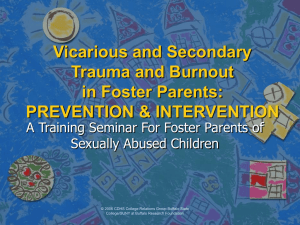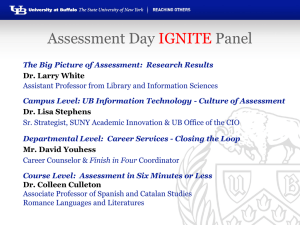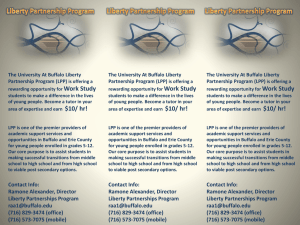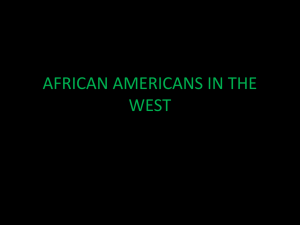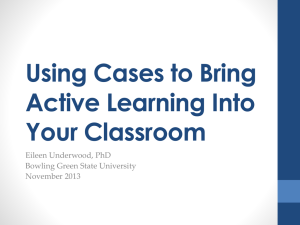Reducing Separation Trauma
advertisement
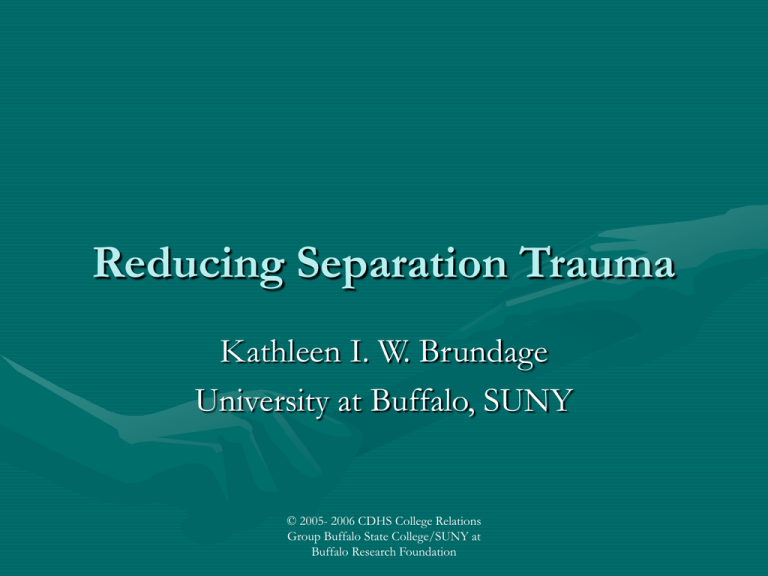
Reducing Separation Trauma Kathleen I. W. Brundage University at Buffalo, SUNY © 2005- 2006 CDHS College Relations Group Buffalo State College/SUNY at Buffalo Research Foundation “Attachment and separation are the heart of child welfare work” – Fahlberg (1991) © 2005- 2006 CDHS College Relations Group Buffalo State College/SUNY at Buffalo Research Foundation Overview • Attachment Review • Separation: Emotional & Psychological Effects • Promoting Attachment in the Foster Home • Current Research Study © 2005- 2006 CDHS College Relations Group Buffalo State College/SUNY at Buffalo Research Foundation Attachment © 2005- 2006 CDHS College Relations Group Buffalo State College/SUNY at Buffalo Research Foundation What is Attachment? • The emotional bond that forms between a child and his or her first primary caregiver and sets the stage for all of the child’s future relationships and the ways in which the child interacts with the world (Bowlby, 1988) • The capacity for emotional security, closeness, and autonomy which develops in response to a predictable pattern of warmth, sensitivity, responsiveness, and dependability from a significant caregiver (Karen, 1994) © 2005- 2006 CDHS College Relations Group Buffalo State College/SUNY at Buffalo Research Foundation The Attachment Cycle • The child has a need • The child expresses the need by fussing, crying, or otherwise raging • The need is gratified by a caregiver, who provides movement, eye contact, speech, warmth, and/or feeding • This gratification leads to the development of the child’s trust in others NEED AROUSAL TRUST (Rage/Fussing) GRATIFICATION © 2005- 2006 CDHS College Relations Group Buffalo State College/SUNY at Buffalo Research Foundation Secure Attachment throughout the Lifespan • Greater curiosity and persistence as a toddler • Positive peer relationships in preschoolers • Advanced cognitive functioning during middle childhood • Development of a social conscience and positive self-concept in adolescence • Healthy, reciprocal relationships in adulthood – Webster (1999); Allen & Ladd (1999); Feeney (2000) © 2005- 2006 CDHS College Relations Group Buffalo State College/SUNY at Buffalo Research Foundation Secure Attachment • • • • • • • • • Emotional Resilience Adaptability to new situations Self-reliance and feelings of self-worth Ability to cope with stress and frustration Flexible thinking Ability to modulate emotion Attain full intellectual potential Able to sort out perceptions and think logically Development of social emotions and able to trust others • Conscience development © 2005- 2006 CDHS College Relations Group Buffalo State College/SUNY at Buffalo Research Foundation – Kagan (2004) Attachment Styles • Secure • Insecure – Insecure-Avoidant – Insecure-Ambivalent – Insecure-Disorganized © 2005- 2006 CDHS College Relations Group Buffalo State College/SUNY at Buffalo Research Foundation Insecure Attachment • Avoidant – Act distant • Ambivalent – Constantly clamor for attention and nurturance, never comforted • Disorganized – Contradictory behavior with the caretaker © 2005- 2006 CDHS College Relations Group Buffalo State College/SUNY at Buffalo Research Foundation School-Age and Adolescence • Avoidant – Affective disorder (depression) – Obsessive Compulsive Disorder – Histrionic, borderline, and schizotypal personality disorders • Ambivalent – Conduct disorder – Substance abuse – Narcissistic or antisocial personality disorder • Disorganized – Aggression – Oppositional Defiant Disorder - Lyons-Ruth (1996); Rosenstein & Horowitz (1996) © 2005- 2006 CDHS College Relations Group Buffalo State College/SUNY at Buffalo Research Foundation Attachment Problems Can Cause: • Problems with Emotional development • Problems with Psychosocial development • Problems with Cognitive development, esp. Language delays • Motor delays • Physical health problems • Neurological problems • Growth delays • Problems with Behavioral regulation (see Handout 1) – Carlson et al.(2003); Fahlberg (1991); Feeney (2000); Leslie et al. (2002); Moss (2205); Schore (2001); Seigel (2001) © 2005- 2006 CDHS College Relations Group Buffalo State College/SUNY at Buffalo Research Foundation Attachment Disorder • A constellation of aberrant attachment behaviors and other social behavioral abnormalities resulting from “pathogenic care” (APA, 2000, p 130) • Affects children who have been – – – – Traumatized Neglected Parents suffering from depression, mental illness, addictions Experienced physical, sexual, and/or emotional abuse – APA (2000); Keck & Kupecky (2002) © 2005- 2006 CDHS College Relations Group Buffalo State College/SUNY at Buffalo Research Foundation …AD • Two clinical patterns: 1) Emotionally withdrawn/inhibited 2) Indiscriminately social/disinhibitied • Have learned that the world is unsafe and have trouble trusting others • Characteristics (see Handout 2) – APA (2000); Cline (1990); Keck & Kupecky (2002); Levy & Orlans (1998) © 2005- 2006 CDHS College Relations Group Buffalo State College/SUNY at Buffalo Research Foundation AD in Adolescence • • • • • • Oppositional Defiant Disorder Attention Deficit Hyperactivity Disorder Affective Disorders (Depression) Serious criminal behavior Hard drug use Psychiatric disturbances in adulthood – Greenberg (1999); Ladnier & Massanari (2000); Dozier et al. (1999) © 2005- 2006 CDHS College Relations Group Buffalo State College/SUNY at Buffalo Research Foundation Attachment and Foster Children • • • • • Loss of primary caregiver Often experience multiple placements 70%+ are removed due to abuse and/or neglect About half have disordered attachments Expectations & adaptive strategies learned in original attachment relationship are maladaptive in context of new relationships – CWLA (2002); Finzi et al. (2001); Newton et al. (2000) © 2005- 2006 CDHS College Relations Group Buffalo State College/SUNY at Buffalo Research Foundation Separation © 2005- 2006 CDHS College Relations Group Buffalo State College/SUNY at Buffalo Research Foundation What do Foster Children lose? • Parents/caregivers • Siblings (in some situations) • Grandparents, other relatives • Friends • Pets • Home • Neighborhood & community • Belongings • Image of themselves and their families © 2005- 2006 CDHS College Relations Group Buffalo State College/SUNY at Buffalo Research Foundation Emotional Response to Separation • Fear • Helplessness • • • • • • • Horror Sense of loss Anger Sadness Guilt Confusion Loneliness Trauma Grief • See Handout 3 - Chapman et al. (2004); Hughes (1997); Johnson et al. (1995); Kagan (2004); Kobak (1999); Mauk & Sharpnack, (1999); Waddell & Thomas (1998) © 2005- 2006 CDHS College Relations Group Buffalo State College/SUNY at Buffalo Research Foundation Behavioral Responses to Separation • • • • • • Bullying and hostile behavior Lying Stealing Aggression toward peers Thoughts of suicide Substance abuse –Delaney (1991); Hughes (1997); Newton et al. (2000); Penzerro & Lein (1995); Rosenstein & Horowitz (1996) Sroufe et al. (2003) © 2005- 2006 CDHS College Relations Group Buffalo State College/SUNY at Buffalo Research Foundation When Separation Trauma Remains Unresolved: • Disproportionately high involvement in mental health, juvenile justice, and adult criminal justice systems • Difficulty in future relationships – Delaney (1991); Hughes (1997); Newton et al. (2000); Penzerro & Lein (1995); Rosenstein & Horowitz (1996) Sroufe et al. (2003) © 2005- 2006 CDHS College Relations Group Buffalo State College/SUNY at Buffalo Research Foundation Factors Affecting the Severity of a Child’s Reaction to Separation • • • • Child’s age and stage of development Significance of the lost person(s) Past experiences with separation Child's perceptions of the reason for separation • Length of the separation © 2005- 2006 CDHS College Relations Group Buffalo State College/SUNY at Buffalo Research Foundation Factors Affecting the Severity of a Child’s Reaction to Separation • Child’s behavior and temperament • Preparation for the move • Post-separation environment, including caregiver state of mind – Barber (2001); Barber & Delfabbro (2003); Bernier & Dozier (2003); Chapman et al. (2004); Cournos (2002); Fahlberg (1991); Heinicke & Westheimer (1966); Mauk & Sharpnack (1999); McFadden (1992); Newton et al. (2000); Penzerro & Lein (1995); Redding et al. (2000); Rycus & Hughes (1998). © 2005- 2006 CDHS College Relations Group Buffalo State College/SUNY at Buffalo Research Foundation Promoting Attachment in the Foster Home © 2005- 2006 CDHS College Relations Group Buffalo State College/SUNY at Buffalo Research Foundation Child Barriers to Attachment • Prior relationship disruptions give a sense of relationships as inconsistent and undependable • Disturbed expectations about relationships • Disturbances in interpersonal relatedness • Developmental delays (esp. speech and language) • Behavior problems • Disturbances in sense of self • Emotion regulation problems – Zeanah & Smyke (2005) © 2005- 2006 CDHS College Relations Group Buffalo State College/SUNY at Buffalo Research Foundation Foster Parent Barriers to Attachment • Trained in previous era when foster parents were told not to “get too attached” • The child is not raised by the foster parent from birth • Misrepresentation of child’s needs and experience – Viewing child as “damaged goods” – Believe the child “merely” needs structure and affection © 2005- 2006 CDHS College Relations Group Buffalo State College/SUNY at Buffalo Research Foundation …Foster Parent Barriers • Stepping around/covering up the child’s traumatic history and painful feelings • Foster parent’s unresolved losses • Insecure attachment style of foster parent – Bernier & Dozier (2003); Dozier et al. (2001); Zeanah & Smyke (2005) © 2005- 2006 CDHS College Relations Group Buffalo State College/SUNY at Buffalo Research Foundation • Adults who care for needy children are often those who have experienced childhood trauma themselves – Cournos (2002); Redding et al. (2000) © 2005- 2006 CDHS College Relations Group Buffalo State College/SUNY at Buffalo Research Foundation Foster Parent Attachment Styles Foster Parent Population Adult Population at large Secure 32% 70% Insecure 68% 30% © 2005- 2006 CDHS College Relations Group Buffalo State College/SUNY at Buffalo Research Foundation – Steele et al. (2003) The Issue of Foster Parent Attachment • Foster parent state of mind with regard to attachment is a stronger predictor of infant attachment than age at placement, and may mediate the effects of abuse/neglect history. – Children under 2 y/o, 3 months after placement: • Secure foster parent – 79% secure foster children • Insecure foster parent – 37% secure foster children © 2005- 2006 CDHS College Relations Group Buffalo State College/SUNY at Buffalo Research Foundation – Dozier et al. (2001) Insecure Attachment • Caregivers with insecure attachment styles tend to step around the child’s trauma • They tend to distance themselves from troubling emotions – Steele, Kaniuk, Hodges, Haworth, & Huss (2003) © 2005- 2006 CDHS College Relations Group Buffalo State College/SUNY at Buffalo Research Foundation Secure Foster Parent Attachment • More accurate interpretation of child’s behavior (recognize anger and despair underlying acting out behavior) • Accurate understanding of child’s developmental level (important for attunement to child’s needs) • Better foster parent-foster child bonding © 2005- 2006 CDHS College Relations Group Buffalo State College/SUNY at Buffalo Research Foundation – Bernier & Dozier (2003) Training is Key • Foster parents need to understand: – The developmental status of the child (Handout 4) – The child’s particular background • Personality • Attachment history • Thoughts & feelings about the family – Bernier & Dozier (2003); Mennen & O’Keefe (2004); Rycus & Hughes (1998) © 2005- 2006 CDHS College Relations Group Buffalo State College/SUNY at Buffalo Research Foundation …Training & Support • Foster parents benefit from training in recognizing what young foster children actually need, not necessarily what they signal that they need – Children placed later than 12 months old typically display behaviors of insecure attachment styles – Foster mothers tend to respond “in kind” – “Powerfully self-perpetuating cycle” – Dozier et al (2002); Stovall & Dozier (2000); Mennen & O’Keefe (2005); © 2005- 2006 CDHS College Relations Zeanah & Smyke (2005) Group Buffalo State College/SUNY at Buffalo Research Foundation …Training & Support • Assessments of foster child attachment • Regular phone contact with support teams (Child Welfare Workers) • Support Groups • Regularly scheduled foster parent training sessions (child development, attachment, behavior modification) Significant decrease in child behavior problems (even for children with AD) – Mennan & O’keefe (2005); Zeanah & Smyke (2005) © 2005- 2006 CDHS College Relations Group Buffalo State College/SUNY at Buffalo Research Foundation …Training and Support • Supporting collaborative relationships between foster parents and social workers promotes foster parent selfefficacy and removes barriers to attachment – Foster parents should be valued for their ability to provide input regarding child development • Social workers should be encouraged to provide foster parents with needed info but also to be open to foster parent input – Mennan & O’Keefe (2005); Zeanah & Smyke (2005) © 2005- 2006 CDHS College Relations Group Buffalo State College/SUNY at Buffalo Research Foundation Current Study Needs Assessment for Reducing Separation Trauma: Foster Child & Foster Parent Attachment and Preparation for Placement © 2005- 2006 CDHS College Relations Group Buffalo State College/SUNY at Buffalo Research Foundation Preparation for Placement – History of abuse or neglect – Developmental level (especially communication level) – Habits and preferences for things like eating, sleeping, and bathing – – – – Medical needs Interests and skills Behavior problems Fears and anxieties and how the child typically expresses those and is accustomed to being comforted Do foster parent and social worker reports agree? Do foster parents need more preparatory support? © 2005- 2006 CDHS College Relations Group Buffalo State College/SUNY at Buffalo Research Foundation Child’s Behavior & Temperament • Attachment Disorder Checklist (Becker-Weidman, 2001) – 50% of foster children nation-wide present clinically significant symptoms of AD – Many foster parents are under-trained to recognize possible signs of AD Foster Parent and Child Welfare Staff reports of child behavior to i.d. whether symptoms of AD are recognized at the rate specified in the research literature Implications for future research: may add to limited body of knowledge on school-age and adolescent foster child attachment © 2005- 2006 CDHS College Relations Group Buffalo State College/SUNY at Buffalo Research Foundation Foster Parent State of Mind with Regard to Attachment • Foster Parent self-report assessment of attachment style • Child Welfare Worker observations of foster parent attachment behaviors Does self-reported attachment style agree with social worker reports of attachment behavior? Need for education about attachment-promoting attachment behaviors? © 2005- 2006 CDHS College Relations Group Buffalo State College/SUNY at Buffalo Research Foundation Research Questions Overall, do foster parent and child welfare worker reports agree? Are there relationships between preparation for placement and foster child behavior/foster parent attachment? Is there a relationship between foster child attachment behavior and foster parent attachment style? © 2005- 2006 CDHS College Relations Group Buffalo State College/SUNY at Buffalo Research Foundation Thank you. Questions? © 2005- 2006 CDHS College Relations Group Buffalo State College/SUNY at Buffalo Research Foundation References Allen, J. P., & Land, D. (1999). Attachment in adolescence. In In J. Cassidy & P. R. Shaver (Eds.), Handbook of attachment: Theory, research, and clinical applications (pp. 319–335). New York: Guilford Press. American Psychiatric Association (2000). Diagnostic and statistical manual of mental disorders (4th ed., text rev.). Washington, DC: Author. Barber, J., Cooper, L. L., & Delfabbro, P. H. (2001). The predictors of unsuccessful transition to foster care. Journal of Child Psychology and Psychiatrty, 42(6), 785-790. Barber, J. G. & Delfabbro, P. H. (2003). The first four months in a new foster placement: Psychosocial adjustment, parental contact and placement disruption. Journal of Sociology and Social Welfare, 30(2), 69-77. Bernier, A., & Dozier, M. (2003). Bridging the attachment transmission gap: The role of maternal mind-mindedness. International Journal of Behavioral Development, 27(4), 355365. Bowlby, J. (1988). A Secure Base. New York: Basic Books. Carlson, E. A., Sampson, M. C., Sroufe, L. A. (2003). Implications of Attachment Theory and Research for Developmental-Behavioral Pediatrics. Journal of Developmental & Behavioral Pediatrics. 24(5), 364-379. Chapman, M. V., Wall, A. & Barth, R. P. (2004). Children’s voices: The perceptions of children in foster care. American Journal of Orthopsychiatry, 74(3), 2930394. © 2005- 2006 CDHS College Relations Group Buffalo State College/SUNY at Buffalo Research Foundation References Child Welfare League of America. (2002). Data and statistics: Out of home care, 2002 [data file]. Available from the Child Welfare League of America National Data Analysis website: http://ndas.cwla.org Cline, F. W., and Fay, J. (1990). Parenting with Love and Logic. Colorado Springs, CO: Pinion Press. Cournos, F. (2002). The trauma of profound childhood loss: A personal and professional perspective. Psychiatric Quarterly, 73(2), 145-156. Delaney, R. J. (1991). Fostering changes: Treating attachment-disordered foster children. Fort Collins, CO: Walter J. Corbett Publishing. Dozier, M., Higley, E., Albus, K. A. & Nutter, A. (2002). Intervening with foster infants’ caregivers: Targeting three critical needs Infant Menatl Health Journal, 23(5), 541-554. Dozier, M., Stovall, K. C., & Albus, K. E. (1999). Attachment and psychopathology in adulthood. In J. Cassidy & P. R. Shaver (Eds.), Handbook of attachment: Theory, research, and clinical applications (pp. 497–519). New York: Guilford Press. Fahlberg, V. I. (1991). A Child’s Journey through Placement. Indianapolis, IN: Perspectives Press. Feeney, J. A. (2000). Implications of attachment style for patterns of health and illness. Child: Care, Health & Development. 26(4), 277-288. © 2005- 2006 CDHS College Relations Group Buffalo State College/SUNY at Buffalo Research Foundation References Finzi, R., Ram, A., Shnit, D., Dov Har-Even, M., Tyano, S., & Weizman, A. (2001). Depressive symptoms and suicidality in physically abused children. American Journal of Orthopsychiatry, 71, 98–107. Greenberg, M. T. (1999). Attachment and psychopathology in childhood. In J. Cassidy & P. R. Shaver (Eds.), Handbook of attachment: Theory, research, and clinical applications (pp. 469– 496). New York: Guilford Press. Heinicke, C. M. & Westheimer, I. (1966). Brief separations. Oxford, England: International U. Press. Hughes, D. A. (1997). Facilitating Developmental Attachment: The Road to emotional recovery and Behavioral Change in Foster and Adopted Children. North Bergen, NJ: Book-mart Press. Johnson, P. R., Yoken, C., & Voss, R. (1995). Family foster care placement: The child’s perspective. Child Welfare, 74, 959-974. Kagan, R. (2004). Rebuilding attachments with traumatized children: Healing from losses, violence, abuse, and neglect. New York: Haworth Press. Karen, R. (1994). Becoming attached: Unfolding the mystery of the infant-mother bond and its impact on later life. New York NY: Warner Books. Keck, G. H. & Kupecky, R. M. (2002). Parenting the hurt child: Helping adoptive families heal and grow. Colorado Springs, CO: Pinon. © 2005- 2006 CDHS College Relations Group Buffalo State College/SUNY at Buffalo Research Foundation References Kobak, R. (1999). The emotional dynamics of disruptions in attachment relationships. in J. Cassidy & P. R. Shaver (Eds.), Handbook of attachment: Theory, research, and clinical applications (pp. 21-43). New York: Guilford Press. Ladnier, R. D. & Massanari, A. E. (2000). Treating ADHD as attachment deficit hyperactivity disorder. In T. M. Levy (Ed.), Handbook of Attachment Interventions (pp. 2766). San Diego, CA: Academic Press. Leslie, L. K., Gordon, J. N., Ganger, W., & Gist, K. (2002). Developmental delay in young children in child welfare by initial placement type. Infant Mental Health Journal, 23(5), 469-516. Levy, T. M. & Orlans, M. O. (1998). Attachment, Trauma, and Healing: Understanding and Treating Attachment Disorder in Children and Families. Washington, D.C.: Child Welfare League of America Press. Lyons-Ruth, K. (1996). Attachment relationships among children with aggressive behavior problems: The role of disorganized early attachment patterns. Journal of Consulting and Clinical Psychology, 64(1), 64-73. Mauk, G. W. & Sharpnack, J. D. (1999). Grief. In G. Mauk & J. D. Sharpnack (Eds.), Children’s needs’ Development, problems, and alternatives. Bethesda, MD: National Association of School Psychologists. Mennen, F. E., & O’Keefe, M. (2004). Informed decisions in child welfare: The use of battachment theory. Children and Youth Services Review, 27,577-593. © 2005- 2006 CDHS College Relations Group Buffalo State College/SUNY at Buffalo Research Foundation References McFadden, E. J. (1992). The inner world of children and youth in care. Community Alternatives: International Journal of Family Care, 4(1), 1-17. Newton, R., Litrownik, A. J., & Landsverk, J. A. (2000). Children and youth in foster care: disentangling the relationship between problem behaviors and number of placements. Child Abuse & Neglect, 10, 1363-1374. Penzerro, R. M. & Lein, L. (1995). Burning their bridges: Disordered attachment and foster care discharge. Child Welfare, 74(2), 351-366. Redding, R. E., Fried, C., & Britner, P. A. (2000). Predictors of placement outcomes in treatment foster care: Implications for foster parent selection and service delivery. Journal of Child and Family Studies, 9(4), 425-477. Rosenstein, D. S., & Horowitz, H. A. (1996). Adolescent attachment and psychopathology. Journal of Consulting & Clinical Psychology. 64(2), 244-253. Rycus, J. S. & Hughes, R. C. (1998). Field Guide to Child Welfare. Washington, DC: Child Welfare League of America Publications. Schore, A. N. (2001). The effects of early relational trauma on right brain development, affect regulation, and infant mental health. Infant Mental Health Journal, 22, 201-269. Siegel, D. J. (2001). Toward a interpersonal neurobiology of the develoing mind: Attachment relathioships, “mindsight,” and neural integration. Infant Mental Health Journal, 22, 67-94. © 2005- 2006 CDHS College Relations Group Buffalo State College/SUNY at Buffalo Research Foundation References Sroufe,. L. A.; Egeland, B., & Kreutzer, T. (1990). The fate of early experience following developmental change: Longitudinal approaches to individual adaptation in childhood. Child Development, 61(5),1363-1373. Steele, M., Hodges, J., Kaniuk, J., Hillman, S., & Henderson, K. (2003). Attachment representations and adoption: Associations between maternal states of mind and emotion narratives in previously maltreated children. Journal of Child Psychotherapy, 29(2), 187-205. Stovall, K. C., & Dozier, M. (2000). The development of attachment in new relationship: Single subject analyses for ten foster infants. Development and Psychopathology, 12(2), 133156. Waddell, D. & Thomas, A. (1998). Disaster: Helping children cope. Bethesda, MD: National Association of School Psychologists. Retrieved May 25, 2005 from http://www.naspcenter.org Webster, L. (1999). Considerations for the school psychologist when providing services for maltreated foster children: a developmental perspective. The California School Psychologist, 4, 5-17. Zeanah, C. H. & Smyke, A. T. (2005). Building attachment relationships following maltreatment and severe deprivation. In L. J. Berlin, Y. Ziv., L. Amaya-Jackson, & M. T. Greenberg (Eds.), Enhancing early attachments: Theory, research, intervention, and policy (pp. 195-216). New York: Guilford. © 2005- 2006 CDHS College Relations Group Buffalo State College/SUNY at Buffalo Research Foundation
